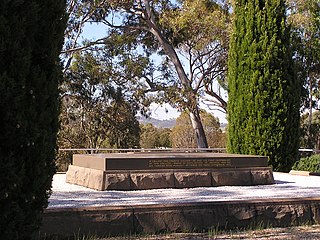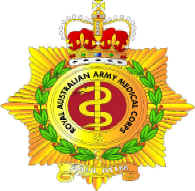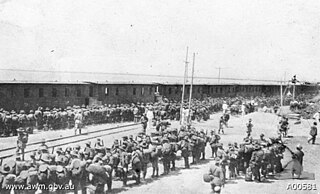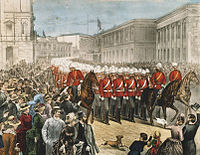
Major General Sir William Throsby Bridges, was a senior Australian Army officer who was instrumental in establishing the Royal Military College, Duntroon and who served as the first Australian Chief of the General Staff. During the First World War he commanded the 1st Australian Division at Gallipoli, where he died of wounds on 18 May 1915, becoming the first Australian general officer to be killed during the war. He was the first Australian officer—and the first graduate of Kingston—to reach the rank of major general, the first to command a division, and the first to receive a knighthood. He is one of only two Australians killed in action in the Great War to be interred in Australia.

Suakin or Sawakin is a port city in northeastern Sudan, on the west coast of the Red Sea, it was formerly the region's chief port, but is now secondary to Port Sudan, about 50 kilometres (30 mi) north.

Lieutenant General Sir Gerald Graham, was a senior British Army commander in the late 19th century and an English recipient of the Victoria Cross, the highest award for gallantry in the face of the enemy that can be awarded to British and Commonwealth forces.

The Royal Australian Army Medical Corps (RAAMC) is the branch of the Australian Army responsible for providing medical care to Army personnel. The AAMC was formed in 1902 through the amalgamation of medical units of the various Australian colonies and was first deployed to South Africa as a small detachment of personnel supporting the Australian Commonwealth Horse during the Second Boer War. The corps has participated in every Australian Army operation since then, including wars and peacekeeping operations. The "Royal" prefix was granted in 1948.
The history of the Australian Army dates back to colonial forces prior to the Federation of Australia in 1901. Some of the colonial forces, which served the states of Australia at the time, were gradually united into federal units between 1899 and 1903; thus forming the beginning of the Australian Army. The colonial armies were officially united as the Commonwealth Military Forces by the Defence Act 1903 (Cwlth). Since then, the Australian Army as an organisation has changed to suit to needs of the nation, with particular changes occurring during and following the World Wars, Korean War, Vietnam War and Gulf War. In 1916 the title 'Australian Military Forces' was adopted and remained its official name until 1980, after which it became known as the Australian Army.

The Royal New South Wales Regiment (RNSWR) is a reserve infantry regiment of the Australian Army based in the state of New South Wales.

Osman Digna was a follower of Muhammad Ahmad, the self-proclaimed Mahdi, in Sudan, who became his best known military commander during the Mahdist War. He is descendant from the Abbasid family. As the Mahdi's ablest general, he played an important role in the fate of General Charles George Gordon and the loss of the Sudan to Turkish-Egyptian rule.

The 1st Battalion was an infantry battalion of the Australian Army. Although its numerical name was designated during the First World War, the 1st Battalion can trace its lineage back to 1854, when a unit of the Volunteer Rifles was raised in Sydney, New South Wales. This unit has since been redesignated a number of times, but through its links with the units of the colonial NSW defence force, the battalion's history includes services in Sudan and South Africa. During the First World War, the 1st Battalion was raised for overseas service in 1914 as part of the First Australian Imperial Force. Attached to the 1st Brigade, the battalion served in Egypt initially before taking part in the fighting in Gallipoli against the Turks. Later the battalion was sent to the Western Front where it fought in the trenches in France and Belgium as part of the Australian Corps. Following the end of the war the battalion was disbanded in 1919.

The 17th Battalion was an infantry battalion of the Australian Army. Although its numerical designation was bestowed upon it during World War I, the 17th Battalion can trace its lineage back to 1860, when a unit of the New South Wales Volunteer Rifles was raised in St Leonards, New South Wales. This unit has since been disbanded and reformed a number times. Through its links with the units of the colonial New South Wales defence force, the battalion's history includes service in the Sudan and South Africa. During World War I, the 17th Battalion was raised for overseas service as part of the Australian Imperial Force. Attached to the 5th Brigade, 2nd Division, the battalion was raised in 1915 and sent to Egypt initially, before taking part in the fighting at Gallipoli against the Turks. Later the battalion was sent to the Western Front in France and Belgium, where it served in the trenches as part of the Australian Corps. Throughout the course of the war, the battalion won numerous battle honours and its members received many individual awards, however, at the end of the war the battalion was disbanded in April 1919.

The Battle of Tamai took place on 13 March 1884 between a British force under Sir Gerald Graham and a Mahdist Sudanese army led by Osman Digna.

Until Australia became a Federation in 1901, each of the six colonies were responsible for their own defence. From 1788 until 1870 this was done with British regular forces. In all, 24 British infantry regiments served in the Australian colonies. Each of the Australian colonies gained responsible government between 1855 and 1890, and while the Colonial Office in London retained control of some affairs, and the colonies were still firmly within the British Empire, the Governors of the Australian colonies were required to raise their own colonial militia. To do this, the colonial Governors had the authority from the British crown to raise military and naval forces. Initially these were militias in support of British regulars, but British military support for the colonies ended in 1870, and the colonies assumed their own defence. The separate colonies maintained control over their respective militia forces and navies until 1 March 1901, when the colonial forces were all amalgamated into the Commonwealth Forces following the creation of the Commonwealth of Australia. Colonial forces, including home raised units, saw action in many of the conflicts of the British Empire during the 19th century. Members from British regiments stationed in Australia saw action in India, Afghanistan, the New Zealand Wars, the Sudan conflict, and the Boer War in South Africa.

The Battle of Tofrek was fought on 22 March 1885 some 5 miles inland from the port of Suakin on the Red Sea coast of Sudan. A contingent of some 3000 troops from the British and Indian "Suakin Field Force" led by Major General Sir John Carstairs McNeill VC, GCVO, KCB, KCMG was attacked by a Mahdist force under the leadership of Osman Digna. The Mahdists were heavily defeated, losing some 1000 of their 2000 fighters as compared to the loss of 70 British and Indian soldiers plus over 100 casualties.

The Egypt Medal (1882–1889) was awarded for the military actions involving the British Army and Royal Navy during the 1882 Anglo-Egyptian War and in the Sudan between 1884 and 1889.
The Suakin Expedition refers to two military expeditions, led by Major-General Sir Gerald Graham V.C. to Suakin in Sudan, with the intention of destroying the power of the Sudanese military commander Osman Digna and his troops during the Mahdist War. The first expedition took place in February 1884 and the second in March 1885.

The Australian Army and its forerunners have been awarded 248 battle and theatre honours since its formation. The first honour given to an Australian unit came prior to Federation and was awarded to forces from the colony of New South Wales, which contributed a small contingent consisting of an infantry battalion, with artillery and support units to take part in the short-lived British campaign against the Dervish revolt in the eastern Sudan in 1885 following the death of General Charles Gordon at Khartoum.

Major General John Soame Richardson, was a British Army officer and Commander of the Forces in colonial New South Wales. He was born in Heydon, Norfolk, England.

The Australian Army was the largest service in the Australian military during World War I. The First Australian Imperial Force (AIF) was the Army's main expeditionary force and was formed from 15 August 1914 with an initial strength of 20,000 men, following Britain's declaration of war on Germany. Meanwhile, the separate, hastily raised 2,000-man Australian Naval and Military Expeditionary Force (AN&MEF), landed near Rabaul in German New Guinea on 11 September 1914 and obtained the surrender of the German garrison after ten days; it later provided occupation forces for the duration of the war. In addition, small military forces based on the pre-war Permanent Forces and part-time Citizen Forces were maintained in Australia to defend the country from attack.
Major-General George Hand More-Molyneux (1851–1903) was a senior British Indian Army officer.

Airborne forces raised by Australia have included a number of conventional and special forces units. During the Second World War the Australian Army formed the 1st Parachute Battalion; however, it did not see action. In the post-war period Australia's parachute capability was primarily maintained by special forces units. In the early 1980s a parachute infantry capability was revived which led to the Parachute Battalion Group forming in 1983 based on the 3rd Battalion, Royal Australian Regiment. In 1997, a full time commando regiment was raised that was able to conduct large-scale operations which matured during the 2000s. In 2011, 3 RAR relinquished the parachute role with the Army deciding to opt out of a conventional parachute capability in preference to a special forces large-scale parachute capability.
The uniforms of the Australian Army have changed significantly over the past century, although the accoutrements worn over this period have remained relatively similar. The forces of the Australian colonies and the early forces of the Commonwealth post-Federation in 1901 closely followed the uniforms of the British Army. Since then it has continued to be influenced by British but also US styles, as well as including some distinctly Australian designs, reflecting local conditions and trends.
















